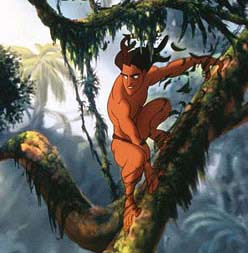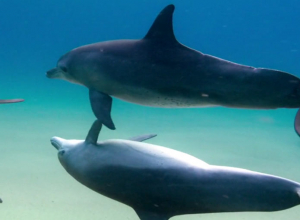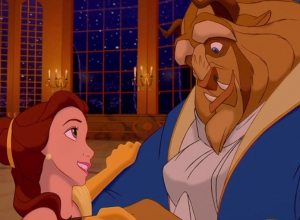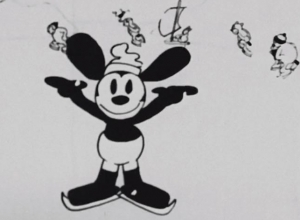
disney Interview
07 January 2009'Tarzan' filmmakers put on a 'dog and pony show,' then hunker down to talk details
Spontaneity does not come naturally to employees of the Walt Disney Company.
Often under attack by conservative groups for offeringdomestic partners benefits and for the occasional controversial movie fromthe company's subsidiaries, the mouse house has become so deeply entrenchedin carefully contrived and politically correct rhetoric that even a friendlyinterview about something as innocuous and universally likable as the studio'slatest instant animated classic, "Tarzan,"is peppered with replies that blatantly tow the company line.
To promote this delightful and technically ground-breakingfeature, Disney flew some of the movie's key behind-the-camera personnelto several major cities in early June to talk about the wondrous and complexprocess of creating the studio's trademark cartoons. The hottest topicwas a new computer-based animation technique called Deep Canvas that adsan incredible realism to the look and movement of the jungle in this lushmovie.
But while most press tours involve being lead into a hotelsuite or conference room for 30 minutes with "the talent" (whicheventually did happen, as you'll see below) each of the "Tarzan"junkets was turned into an event -- it's not every day they intervieweebrings his own A/V guy to orchestrate a multimedia presentation beforethe Q&A begins.
But at the Pan Pacific Hotel in San Francisco on May 27,a room full of reporters was treated to what Thomas Schumacher, presidentof Walt Disney Feature Animation and Walt Disney Theatrical Production,admitted was "a dog and pony show."
Schumacher introduced clips from the film, video of recordingsessions with the voice talent, and a promotional short about the recordingof Phil Collins' soundtrack songs before turning the floor over to thenext motivational speaker...oops, I mean one of the movie's directors,Kevin Lima, who read from a letter "Tarzan" novelist Edgar RiceBurroughs wrote some 60 years ago about wanting to make an animated "Tarzan"movie that would "approximate Disney excellence."
Some months ago the story of this Burroughs directive hadalready been fed to several entertainment magazines by publicists to defuseany "Tarzan" purists out there who might object too loudly about'tooning the king of the apes.
"I went back to the book," Lima said, tappingthe cover of a dusty, old hardback of the Burroughs' novel. "I re-readthe book, and I'm glad I did because there's a great animated movie inthis book."
It was, no doubt, the same speech he had given to severalother rooms of journalists already, and after all the practice he had ithoned to whistle-stop perfection, complete with legislated sound biteslike "We feel really lucky at Disney to work with a great stable ofartists."
Meanwhile, we reporters are getting a little antsy forour face-to-face interviews, which will come only after lead animator GlenKeane, perched on a barstool next to the screen, reads from the journalof his research safari to Africa while clips of monkeys and slides of hissketches cut through the darkened room at predetermined intervals.
Keane kicks the presentation into finale mode by introducinga clip that demonstrates the Deep Canvas technology used in creating thefantastically fluid, nearly three-dimensional images of Tarzan swingingand surfing through the jungle. Then he sketches Tarzan for us on an overheaddisplay while recounting what will no doubt become a famous story abouthow he hit on the idea of having Tarzan "surf" the digitally-enhancedjungle tree trunks by watching his teenage son skateboard.
Finally, we all get our turns to see if we can inspirea little impromptu spirit and get these filmmakers off their script.
No such luck with Schumacher, whose genuine excitementabout the project is overshadowed by his pure Hollywood speech habits ("Weat Feature Animation had been looking at the property..."). He speakspassionately and eloquently about the conscious effort Disney makes togive its films depth and broad appeal, recounting how the removal of Jane'swhite Victorian gloves is used as a metaphor that adults might get, butwould pass over the heads of kids just enjoying the cartoon. But when askeda pointed question about the way the villain meets his doom, the executivebrings out the public relations firehose.
"You don't actually see (it) happen," Schumachersays before launching in to comparisons to other kids movies -- like the"seven-time Academy Award-winning film 'Oliver'" -- in whichvillains are done in. "I think we handled it with grace, I think wehandled it with taste, and I don't think it crosses a line."
Finally off of auto-pilot and into face-making, wild-gesturingcartoon-maker mode, director Lima and animator Keane are a less calculatingwhen I get them alone for an interview. They fondly recall their safari,during which they studied the jungle and a family of gorillas, and revealsome surprises, like the fact that Keane, who was lead designer of theTarzan character, met Tony Goldwyn, the actor who supplied his voice, onlyonce.
Lima, 38 or so, is the sportcoat and ponytail type, minusthe greasy arrogance and plus a vivacious grin that looks like he borrowedit from a very happy 4-year-old.
Keane, maybe 10 year older, has a trusting, doughy facethat looks like it's also quite accustom to smiles and laughter.
After years of making a living in the 'toons, they're areplayful and a bit more unpredictable -- kind of like their target audience.But they still regurgitate studio propaganda when asked any obvious question,giving almost word-for-word the same answers as Schumacher.
Contactmusic.com: Mr. Keane, you worked onthis movie in Disney's Paris animation house, while you, Mr. Lima, andmany of the other animators where in Burbank. How on Earth did you coordinate?
KEVIN LIMA: We actually spoke to each other on aCLI system, which is a video conferencing system. We would look at scenesover that system and act out scenes for each other. I would get up on thetable and act things out (making ape face, and leaning into the tableon underturned knuckles).
GLEN KEANE: I was concerned at first...because inCalifornia was the animator doing Jane and the gorillas, and in Paris wewere doing Tarzan and the leopard. But what I found out was that we almosthad a more personal relationship with them because we had them to ourselvesin the CLI meetings (and) we had control of the camera and could zoom inon faces as they made faces, watching reactions to video to really seetheir spontaneous reactions.
Contactmusic.com: It must have been difficult animatinginteracting characters from two continents.
KEANE: At times. When Tarzan approaches Jane andhe kind of looks up her skirt and BOOM, gets kicked in the face, that partwhere he gets kicked in the face, well, the animator in California is doingthe foot hitting the face and he doesn't know exactly where that face isgoing to be.
Contactmusic.com: So all the scenes where Tarzanis swinging through the vines carrying Jane had to be done with him firstand Jane being animated around him? That sounds so complex.
LIMA: Federal Express became rich during this movie!
KEANE: The only difference was instead of beingin the room next to each other -- that's how we always done it -- you wouldsend it through Federal Express. You would still get it the next day. Thebiggest difference to me was the language. There were translation issues.Kevin would send notes and I'd try to translate what they meant.
LIMA: (The translation problems were) abstract things,like "Tarzan needs to be more earnest in this scene," and thenhow does that get interpreted when we can't look at each other and justmake the face that we want. (Sometimes) we had to just get on our CLI systemand I just did it for them (making a kind, longing face).
Contactmusic.com: Speaking of technology, I thinkits safe to say that this movie is the most integrated use of computeranimation with hand animation that has been done to date. Are there anypitfalls?
LIMA: Well, from the beginning we always said weweren't going to do this Deep Canvas unless it looked exactly like a backgroundpainting. If it were ever noticeable (that they were using computers),we'd have abandon it. (But once we were committed) the first thing youdo is build the jungle in 3D and figure out how your camera is going tomove to follow the characters.
KEANE: And you have to choreograph the movementof the character in there, because once you get it done, it's very difficultto go back in and redo that camera move. Everything changes slightly andno longer is Tarzan matching that background. You'd have to go back andre-animate, which is what I had to do on one scene (of Tarzan surfing thetwisting tree trunks).
Contactmusic.com: What kind of changes are madeto a character once the voice talent is cast?
KEANE: Not many. I met Tony only once, very earlyon, I think before I started doing the designs. I was struck with his eyes.They're intense. I always tell the animators, if you're going to make amistake, do it on something other than the eyes, because that's where everybodyis focusing and identifying with the character.
LIMA: What we do sometimes when we're in the sessionsrecording the dialogue is we'll set up a video camera and we'll video thewhole session. So then the animator, if he wants, can draw upon those tapesto pull expressions, mouth shapes, maybe some gesturing that happens.
KEANE: I remember thinking with Tony what reallystruck me, more than his face, was the quality of his voice...He has thisgreat sort of animal sense to his voice -- a great coarseness, (an) animal-likesound that comes from down here somewhere. (Grunting) Tarzan, Tar-zahn!And you have to animate that. His head drops down (lowers his chin to hischest) and you use the hands like gorilla hands (curls his knucklesunder on the table top), and that's influenced by the voice. Voicescreate images in our minds. I wasn't so concerned about drawing Tony asI was about interpreting animal motions. That's why we spent a lot of timestudying stop-frame videos, learning how a gorilla walks.
LIMA: We didn't ever want Tarzan to feel like hewas just a man. We didn't want him to stand up straight or wave good-bye.We wanted to make sure he always had that piece of gorilla in him, thathe always had an animal attitude about him.
Contactmusic.com: Was that a freedom or a challenge?
KEANE: It was definitely a challenge. (For instance),Tarzan moving through the branches. I'd animated this scene and it didn'tfeel like Tarzan doing it. If felt like a human, like me hanging on vinesand branches. So I studied the gibbon and realized they never look at thebranches when the grab them. They look past. They look where they're going.And then we changed Tarzan so instead of looking at the vines and branches,he just moved right on through confidently, and it felt like Tarzan again.The instinct of an animal had to be there.
Contactmusic.com: And you spent several days inAfrica getting ideas as well. That must have been an adventure.
KEANE: You go there and you're prepared for whatto do if and when a gorilla charges you. You don't look him in the eye,you put your butt up in the air. Everyone did that, I guess, except forKevin when this gorilla kind of walked past. (Laughs.)
LIMA: I couldn't help myself. I just watched him.I mean, I sort of went down, but you only get an hour (with the gorillas)!An hour in your life. I wasn't gonna waste it. And if I got charged, wow!The story I'd have!
KEANE: I really sensed a fear of being in the jungle.I felt very vulnerable and naked being there. In the tent my son and Iwere in, at night you just heard all kinds of noises out there. I mean,I have no idea what the things I was hearing were, but they were runningacross the tent roof (makes rustling and whooping noises), and Iwas so thankful I was in there. I started thinking, how would I surviveif I was out there? I'd be dead! I couldn't handle this. I started appreciatingTarzan in a way I never would have before. I think it was necessary togo there to sense the reality of that.
Contactmusic
Top 10 Videos
Wallace Chung
XXX
1
10 Years
Beautiful
2
Fast Girls
Fast Girls
3
Shaggy
Hey Sexy Lady
4
Air
Sexy Boy
5
The Staves
Tired As F***
6
Robin Thicke
Blurred Lines (Unrated Version)
7
All That Remains
Six (Live)
8
Fugees
Boof Baf
9
Fleur East
Sax [Live]
10
Movies and Trailers

Dolphins Trailer
For their latest endeavour, Disney Nature take us on a journey into the deep blue...

Beauty and the Beast 25th Anniversary Trailer and Clips Trailer
It's been 25 years since Disney released one of their most popular masterpieces, Beauty and...

Sleigh Bells - Clip Trailer
Walt Disney directed the black and white animation with Ub Iwerks in 1928. The film...













